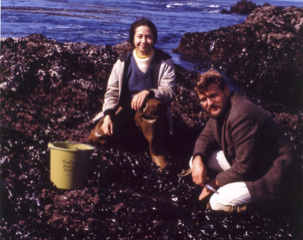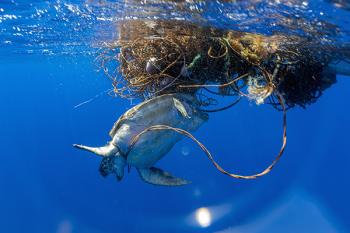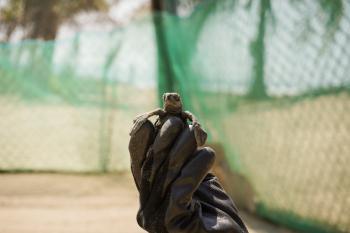“I think people should know about sea anemones. Many people don’t even recognize that anemones are living things.”
Vicki’s Pathway
Vicki grew up in a science family. Both her parents, Ralph and Mildred Buchsbaum, were biologists, well-known for writing a classic zoology textbook Animals Without Backbones. She was drawn to animals as long as she can remember and fell especially for birds at age four when she “discovered finches.” Her continued love of birds is evident as she describes an oystercatcher’s nest that she can observe from her living room. Her parents also introduced her to marine animals at the shore every year. Her father taught general and invertebrate biology at the University of Pittsburgh, and Vicki was in his class (imagine being graded by your father).
Vicki majored in biology and transferred to Stanford when her family moved to California. As a senior she took an invertebrate biology class at Hopkins Marine Station (Stanford’s marine Lab) and continued with her PhD. Though among the very few women graduate students at that time, she always felt encouraged and supported at Hopkins. And it was at Hopkins that she met her science teammate.

The Pearse Team
Vicki and her late husband John Pearse, a professor of ecology and evolutionary biology at UC Santa Cruz, are among the world's leading experts on marine invertebrates. Together or separately, John and Vicki studied and published on echinoderms (sea urchins, sea stars, brittle stars), cnidarians (anemones, corals, box jellies), sponges, and placozoans. Vicki has been a researcher, author, and editor her entire career, never seeking a professorship, always following her curiosity, doing what she enjoyed. Anemones were a favorite: a new species was named for her, and she and a colleague named a new species, too.
The Algal-Anemone Team
Needing to choose a thesis project, Vicki sat down in the library and systematically sampled journals from diverse fields of biology: what would spark her curiosity? Up popped an article about sea anemones that host symbiotic algae.
She began studying the aggregating anemone (Anthopleura elegantissima), abundant in the intertidal at Hopkins. After establishing that the anemones’ green color was not due to the symbionts’ chlorophyll, Vicki became curious about the green pigment the anemones make. On our coast, only three closely related intertidal anemones are green and all have symbiotic algae. A coincidence? This part of her thesis was never published — she was a pioneer in researching the green pigment then. But recently she has worked with others to publish about the function of anemones’ green fluorescent pigment (GFP) as an anti-oxidant.
Next, Vicki focused on the anemones’ behavior: they close at night and open in the morning; they close when the tide goes out, left exposed to the air, and they open when the sea returns. Light-control experiments showed that each anemone can move on its pedal disk in order to be in a certain light level: not too bright and not too dark. These predatory anemones get extra nutrients from their symbiotic algae, which need light for photosynthesis.
The Reef Team
Well-fed anemones can get along as predators without any photosynthetic symbionts adding nutrition. But the corals and calcareous algae that build tropical reefs of calcium carbonate depend on photosynthesis — for their nutrition as well as for the chemical environment that promotes calcification in their skeletons. And photosynthesis depends on light. That’s why healthy reefs are in clear, sunlit, shallow water.
Vicki’s experiments, comparing calcification rates in light vs. dark, confirmed that both corals and calcareous algae calcify faster in the light, when photosynthesis is not only producing nutrition but also taking up carbon dioxide and reducing acidity. Climate change is doing the opposite: adding carbon dioxide and increasing the acidity of ocean waters. In addition, rising ocean temperatures cause the loss of algal symbionts (bleaching) in corals, and ocean acidification damages the ability of both corals and calcareous algae to calcify. The devastating consequences were predictable.
Nonetheless, Vicki advocates for curiosity-based science. She encourages students to follow their curiosity. Be filled with questions and wonder while also being serious and rigorous. Despite the urgency of issues such as climate change and biodiversity loss, they aren’t the only basis for sound, fulfilling science. We know a lot but there’s still lots to find out. And many diverse careers in science await outside of universities: museums, government agencies and non-profits. Vicki says, “You’re not likely to get rich, but you will have a rich life.”















